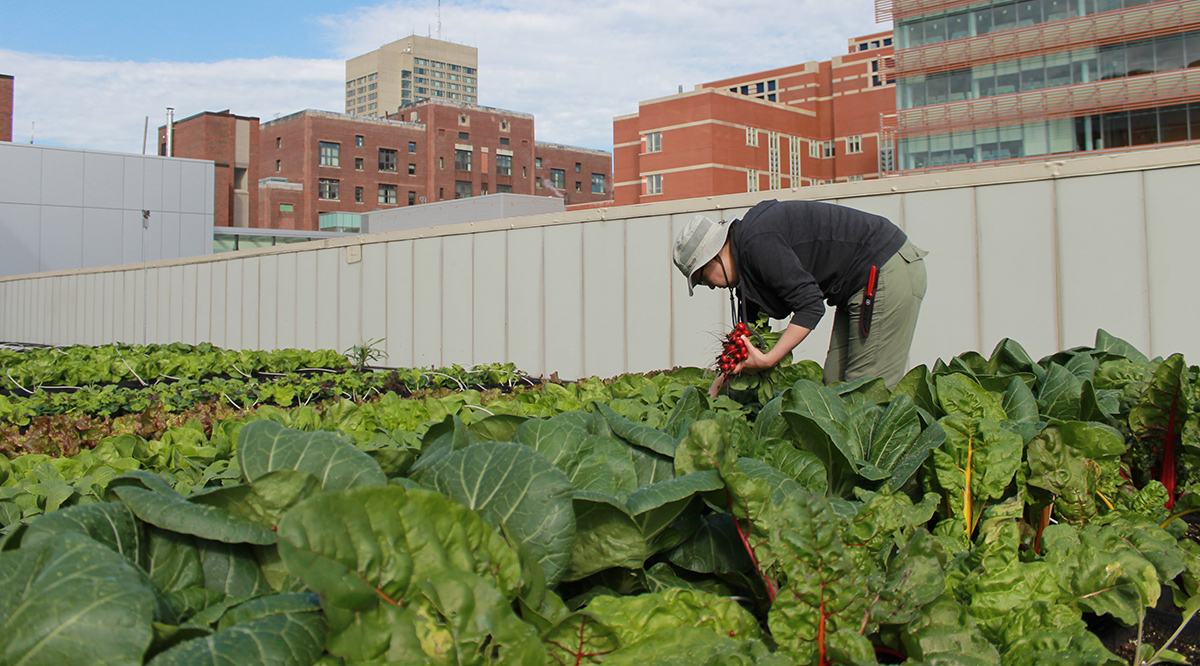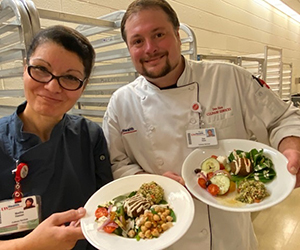
Editor’s note: This article is part of a series on climate change and health. Other articles in this series include stories on how extreme heat affects health, and the impacts of extreme weather on rural, coastal, and underserved communities.
Each year, hospitals across the United States dish up billions of meals. Those responsible for feeding thousands of visitors, patients, and employees every day contemplate numerous issues, from nutrition requirements to skyrocketing expenses.
But increasingly, they also focus on another significant concern: the environmental impact of what they serve and how.
That makes sense given the role that food plays in helping or harming the planet. For example, 34% of greenhouse gas (GHG) emissions worldwide are food-related, according to a 2021 Nature Food article. What’s more, health care has a significant environmental footprint: If the global health care sector were a country, it would be the fifth-largest contributor to GHGs. And a large chunk of hospitals’ environmental impact comes from their food services.
This reality worries health care leaders who want to avoid contributing to environmental problems that can cause or worsen health conditions for the patients and communities they want to protect.
“You just can’t have healthy people on a sick planet,” says John Stoddard, associate director for climate and food strategy at the environmental nonprofit Health Care Without Harm (HCWH). That organization collaborates with nearly 2,000 U.S. hospitals and health systems working on the connection between food and sustainability.
Stoddard notes growing interest in the issue. “About 10 years ago, it was a really hard sell. I would cold-call people to try to convince them, and they didn’t see the connection between food and the environment. Now, they come to me asking what they should do.”
Currently, 81 hospitals have signed the Cool Food Pledge, which aims for a 25% reduction in food-related emissions by 2030. That’s up from 4 hospitals in 2018, when HCWH and other organizations first launched the initiative.
“About 10 years ago, [people] didn’t see the connection between food and the environment. Now, they come to me asking what they should do.”
John Stoddard
Health Care Without Harm
Hospital leaders are approaching the issue from numerous angles, including how their food is produced, transported, prepared, packaged, and discarded. Often, they focus on three key areas: swapping plant-based food for meat, buying locally and responsibly, and discarding waste in more environmentally responsible ways.
“We look at how we can reduce the environmental impact from food at every decision point,” says Diane Imrie, RD, MBA, who oversees the production of 2 million meals annually as director of nutrition at the University of Vermont Medical Center (UVMMC) in Burlington. “This adds up to a big enough effect on the environment that if we were ignoring it, we would feel we were not living up to our commitments to our patients and to the planet.”
The power of plants
Growing plant-based foods (like beans and vegetables) uses less land and water than animal-based options (like meat, poultry, and dairy). It also produces far fewer GHGs. In fact, halving U.S. meat consumption would be tantamount to taking 47.5 million cars off the road, a University of Michigan study estimates.
The number of hospitals working to trim their meat offerings is growing. More than 80% of reporting hospitals in the HCWH network were doing so in 2022, up from 57% in 2017, says Stoddard. Boston Medical Center (BMC) has reduced its beef purchasing by 22% over the past few years, according to Senior Director of Services David Maffeo, and at UCLA Health plant sources of protein now make up more than a third of all protein purchases.
Leaders can turn to some sophisticated tools as they do this work. “We can use a Practice Greenhealth GHG calculator to compare the impact of using 400 pounds of chicken versus 400 pounds of beans,” says Lisa Boté, manager of culinary services for UW Health, which has three hospitals in the Madison region of Wisconsin. “We can even look at the change in GHG emissions if we take out a slice of cheese from a sandwich.”

But making such changes palatable to patients and cafeteria customers isn’t always easy.
“Food is near and dear to people’s hearts. If you start messing around with their options, it can be tough,” says Kyle Tafuri, vice president for sustainability at Hackensack Meridian Health, which has reduced meat-related GHGs at its 18 New Jersey hospitals by 39% in recent years.
Hackensack culinary staff worked to develop some mouth-watering options. For example, beet greens don’t simply get chopped and boiled; they instead appear in a salad with candied walnuts and a citrus dressing. Other hospitals try small steps, like swapping a 100% beef burger for a version that’s 70% beef and 30% mushroom.
At UW Health, those involved thought hard about how to pitch menu changes. “We are Wisconsin. Beef is a staple,” says Megan Waltz, MS, RD, director of culinary services and clinical nutrition. “People may think, ‘Don’t take away my red meat,’ so just encouraging eating more plants can be more acceptable and less shaming.” In addition, staff helped ease cafeteria visitors into plant-based foods by offering free samples of unfamiliar items like garbanzo bean salad and vegetable korma.
When it comes to the animal products they do serve, hospitals are also working to go antibiotic-free. “In this country, more antibiotics are used in meat than in people,” and pervasive use of antibiotics in animals can increase dangerous resistance among humans, says Tafuri.
Antibiotic-free options are more pricey, but serving less meat overall helps — as do other cost-cutting steps. “We’ve worked hard with the team, from the administration down to frontline cooks, to find ways to be responsible financially and environmentally,” Tafuri says. “It can be done.”
Buying locally — and responsibly
In the United States, food often travels thousands of miles from farm to plate, with environmental impacts all along the way.
Imrie still remembers learning about the trajectory of fish she had been buying from Alaska. “It was being flown to China, packaged, frozen, and then shipped back. That was pretty ridiculous,” she says.
But Imrie and others are buying closer to home not just to reduce their “food miles,” but also to encourage local farmers to pursue more environmentally friendly practices.
At UW Health, that means taking into consideration whether certain producers are adopting organic and other environmentally responsible farming techniques. At UVMMC, it means providing local partners with a more robust seed base, one that boosts water absorption and habitats for pollinators.
At BMC, much of the produce served is hyper-local: grown right on top of one of the hospital’s buildings. The 2,658-square-foot farm, launched in 2017, yields about 5,600 pounds of fruit and vegetables each year.
The roof farm offers many environmental upsides besides zero food miles. Plants ingest carbon dioxide and other pollutants, says Maffeo, and they cut energy use by serving as an extra layer of insulation. They also absorb rainwater, which prevents storm drains and rivers from being flooded by runoff.
Now, BMC is getting ready to expand its agricultural efforts with a new farm on a second building. Scheduled to open this summer, the new spot will yield twice as much produce.
Waste, not!
Food-related refuse accounts for 10% to 15% of all hospital waste produced each year. Just one hospital kitchen alone can churn out hundreds of tons of food waste annually.
That’s worrisome, environmental leaders say, in part because discarded food unleashes dangerous GHGs as it decays. In fact, cutting U.S. food waste in half would reduce GHGs by the same amount as shuttering 23 coal-fired power plants.
Some hospitals are working to curtail food waste before it happens. Doing so often involves methodically measuring unused items. At Hackensack Meridian, for example, kitchen staff load discarded food into containers or onto scales — and then use computer-generated reports to inform future meal-planning efforts.
The Hackensack team has begun slicing more produce in-house — pre-cut veggies spoil faster — and aims to use items like potato peels in recipes instead of tossing them. “We also realized that we could quickly move desserts that never made it onto patient trays into the cafeteria,” he says.
At Wisconsin, a room service model for patient meals trims waste. “Patients can call and order à la carte from a full restaurant-style menu. They might choose a serving of cottage cheese, a salad, and French fries,” says Waltz. “If patients pick what they want, we see less food being wasted.”
Imrie, who also uses the room service model for patients at UVMMC, points to another advantage: Food arrives only when patients are hungry. Adopting the model led to a 20% reduction in food waste within a year, she notes.
But reducing waste is not about consumables alone. Hospitals are also looking to decrease disposable items like plastic utensils that are destined for the dump. UVMMC is preparing to install takeout containers that patrons can return for cleaning and reusing. At UCLA Health, all disposables for patients and customers are compostable or recyclable. Cafeteria staff also offer a discount to customers who bring or buy reusable mugs, and once the health system finishes installing water-filling stations in the next few months, it will no longer sell any single-use plastic water bottles.
“We have hard jobs. We work with flames and knives, but knowing that we are producing food that tastes good, is good for you, and helps protect the environment is great. We can say, ‘I’m proud of what I did today.’”
Lisa Boté
UW Health
Ultimately, though, some kitchen items will continue to get tossed, and leaders are trying to handle waste in the best ways possible.
Composting is popular for its dual benefits: It decreases trash and replenishes soil. “We compost everything,” says Imrie. “If you leave half a sandwich on your cafeteria tray, we compost it. We compost kitchen food scraps. And we compost off the trays that come back from patient rooms.”
At BMC, kitchen staff use a biodigester, a machine that breaks down food easily and quickly. Waste goes in, and a couple of days later emerges as wastewater that gets flushed down the drain. BMC disposes of 2 tons of food trash this way monthly, says Maffeo.
UW Health is also thinking of adding a biodigester, and Waltz thinks her institution will support the purchase if it’s the best long-term choice despite the potential upfront price tag. “There are a lot of leaders here who understand that you can’t necessarily put a dollar amount on what something means for the environment,” she says.
Boté adds that kitchen staff appreciate this orientation. “We have hard jobs. We work with flames and knives, but knowing that we are producing food that tastes good, is good for you, and helps protect the environment is great. We can say, ‘I’m proud of what I did today.’”
